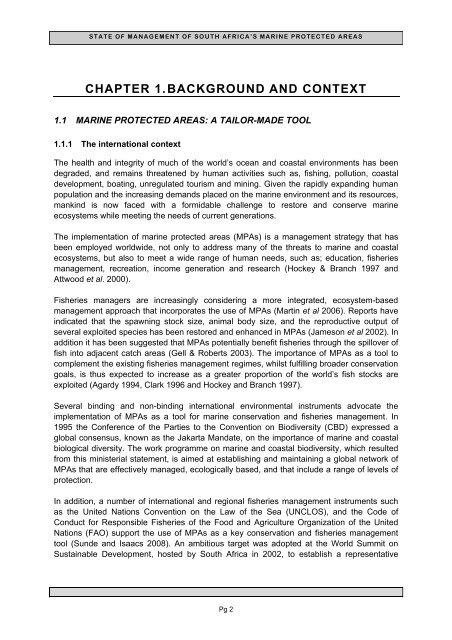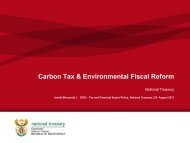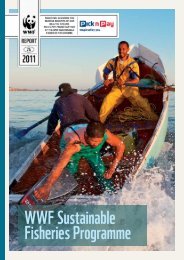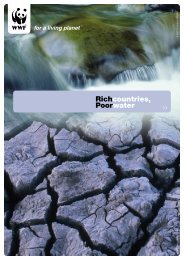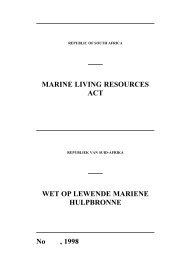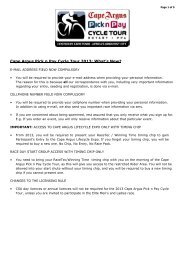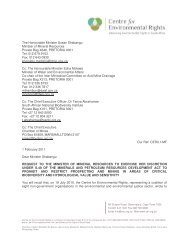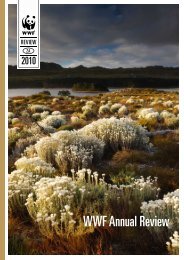State of Management of South Africaââ¬â¢s ... - WWF South Africa
State of Management of South Africaââ¬â¢s ... - WWF South Africa
State of Management of South Africaââ¬â¢s ... - WWF South Africa
- No tags were found...
You also want an ePaper? Increase the reach of your titles
YUMPU automatically turns print PDFs into web optimized ePapers that Google loves.
STATE OF MANAGEMENT OF SOUTH AFRICA’S MARINE PROTECTED AREASCHAPTER 1. BACKGROUND AND CONTEXT1.1 MARINE PROTECTED AREAS: A TAILOR-MADE TOOL1.1.1 The international contextThe health and integrity <strong>of</strong> much <strong>of</strong> the world’s ocean and coastal environments has beendegraded, and remains threatened by human activities such as, fishing, pollution, coastaldevelopment, boating, unregulated tourism and mining. Given the rapidly expanding humanpopulation and the increasing demands placed on the marine environment and its resources,mankind is now faced with a formidable challenge to restore and conserve marineecosystems while meeting the needs <strong>of</strong> current generations.The implementation <strong>of</strong> marine protected areas (MPAs) is a management strategy that hasbeen employed worldwide, not only to address many <strong>of</strong> the threats to marine and coastalecosystems, but also to meet a wide range <strong>of</strong> human needs, such as; education, fisheriesmanagement, recreation, income generation and research (Hockey & Branch 1997 andAttwood et al. 2000).Fisheries managers are increasingly considering a more integrated, ecosystem-basedmanagement approach that incorporates the use <strong>of</strong> MPAs (Martin et al 2006). Reports haveindicated that the spawning stock size, animal body size, and the reproductive output <strong>of</strong>several exploited species has been restored and enhanced in MPAs (Jameson et al 2002). Inaddition it has been suggested that MPAs potentially benefit fisheries through the spillover <strong>of</strong>fish into adjacent catch areas (Gell & Roberts 2003). The importance <strong>of</strong> MPAs as a tool tocomplement the existing fisheries management regimes, whilst fulfilling broader conservationgoals, is thus expected to increase as a greater proportion <strong>of</strong> the world’s fish stocks areexploited (Agardy 1994, Clark 1996 and Hockey and Branch 1997).Several binding and non-binding international environmental instruments advocate theimplementation <strong>of</strong> MPAs as a tool for marine conservation and fisheries management. In1995 the Conference <strong>of</strong> the Parties to the Convention on Biodiversity (CBD) expressed aglobal consensus, known as the Jakarta Mandate, on the importance <strong>of</strong> marine and coastalbiological diversity. The work programme on marine and coastal biodiversity, which resultedfrom this ministerial statement, is aimed at establishing and maintaining a global network <strong>of</strong>MPAs that are effectively managed, ecologically based, and that include a range <strong>of</strong> levels <strong>of</strong>protection.In addition, a number <strong>of</strong> international and regional fisheries management instruments suchas the United Nations Convention on the Law <strong>of</strong> the Sea (UNCLOS), and the Code <strong>of</strong>Conduct for Responsible Fisheries <strong>of</strong> the Food and Agriculture Organization <strong>of</strong> the UnitedNations (FAO) support the use <strong>of</strong> MPAs as a key conservation and fisheries managementtool (Sunde and Isaacs 2008). An ambitious target was adopted at the World Summit onSustainable Development, hosted by <strong>South</strong> <strong>Africa</strong> in 2002, to establish a representativePg 2


